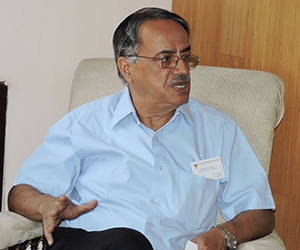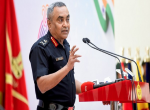Have we learned any lessons from our experiences during the Nehru era and in subsequent years? Anyone looking dispassionately at our defence and security policies over the decades would respond only in the negative. India frittered away its militarily advantageous position towards the end of Indo-Pakistan War of 1971 when we failed to exploit the operational situation in the Western Front that could have given us back our territory. This was much like towards the end of 1947-48 Indo-Pak conflict when Indian forces were ordered to stop operations. After the cessation of hostilities in 1971, we allowed Pakistan a victory on the negotiating table when India could have at least forced Pakistan’s Prime Minister Zulfikar Ali Bhutto in the Simla Agreement of 1972, to convert the cease fire line into a permanent border as we had over 90,000 Pakistani soldiers in our custody.
Some specious response from Bhutto as to what face will he show to Pakistani public was accepted as a justified explanation. Our politico-bureaucratic psyche apparently is averse to following hard policy choices in pursuit of our well cherished and identifiable national interests. Leeway given to Bhutto then and his single minded pursuit of building an Islamic bomb that was successful has created more obstacles for settling the Kashmir issue favourably from the Indian point of view.
Like Nehru allowed Sheikh Abdullah and his cohorts to travel to Pakistan and exchange views with the Pakistani leadership, we continue to show irrational leniency to the separatist Hurriyat leadership and other hostile and anti-national elements to not only confer with officials of Pakistan’s High Commission in New Delhi but also to travel to Pakistan, obviously for purposes that would be contrary to India’s national interests.
It is a well known fact that such Kashmiri leaders have met those very leaders who sponsor terrorism both in Kashmir and all over India. It needs to be remembered that Sheikh Abdullah, in what is known as Kashmir Conspiracy case, was charged with treason for arranging to supply arms and explosives sourced from Pakistan as part of a conspiracy against the State. Despite the proof presented to Nehru about the involvement of Sheikh Abdullah in the conspiracy, he got him released and allowed him to Pakistan under the mistaken belief that something good might come out of the visit.
Currently, the present government is again inclined to follow soft policies towards Pakistan based on professions of peace by the newly elected Prime Minister Nawaz Sharif knowing very well that Pakistan’s India and Afghanistan policies are dictated by the military and security establishment. Plans by Prime Minister Manmohan Singh to visit Pakistan based on the invitation extended by Nawaz Sharif have not been entirely discarded even as India has been waiting for Islamabad to deliver on the masterminds of 26/11 Mumbai terrorist attacks. It is quite evident that there has been no fundamental change in perceptions of Pakistani establishment that it is only cross-border terrorism that moves India to engage with Pakistan and possibly give some concessions to them especially on Kashmir.
While India has somehow managed to handle military and security threats from Pakistan, it is the ever expanding Pakistan-China nexus that presents an invidious and most dangerous threat to India’s security. It is only a few years back that the Indian Army started propagating a military doctrine to meet the threat of two front war. In a throwback to the Nehruvian policies, the government was more inclined to handle such threats diplomatically rather than spend additional defence funds for arising and equipping of requisite military formations and necessary air support.
The report ‘Non Alignment 2.0: A Foreign and Strategic Policy for India in Twenty First Century’ authored by a group of eminent experts, that included a member from National Security Advisor (NSA) Shiv Shankar Menon’s staff and where NSA also attended some of the deliberations of the group, while talking about military capabilities has opined that “we need to be clear about what kinds of offensive capabilities will be useful. The prevailing assumption that we should raise and deploy a 'mountain strike corps' against China is problematic. For it simply risks replicating all the problems with our existing strike corps under worse geographic and logistic conditions.” 1 In short, it is not only the economic burden of raising such forces but the mindset about provoking China redolent of Nehru era persists. The report also talks of instigating an insurgency in our areas after they have been captured by the Chinese forces which conveys a defeatist attitude.
Further, what needs to be noticed is that since 2008 not only PLA has improved its posture in Tibet it has undertaken a number of incursions across the Line of Actual Control. This stance of assertive PLA in Tibet has been made possible by the massive build up of logistic structure in Tibet to include extensive railway network and over 58,000 kilometres of roads. The roads have been built up to Indian borders and have also penetrated Nepal. This would ensure smooth induction of the PLA troops in any contingency. This contrasts with our poor civil and military structure even after a lapse of over six decades. No doubt India has recently embarked on activating its old airfields along Sino-Indian border and the MOD has chalked out a plan for building extensive road net work and other infrastructure facilities but our record in implementing plans and projects has so far been very tardy. Thus the asymmetrical situation with China that existed in past during Nehruvian times and thereafter has not been rectified.
Recent incursions by the PLA in Depsang and Chumar areas of Ladakh sector also reveals the government’s disinclination to reveal such incidents along the border to the public which conforms to its past practice of withholding such information from the public lest it may embarrass the government in some manner or the other. Apparently, Foreign Minister Salman Khurshid and later Defence Minister Mr. AK Antony have visited Beijing subsequent to these incidents in April and June 2013 which seemed from all angles as conciliatory gestures to China’s aggressive policies in line with appeasement policies of Nehru.
The deficiencies in terms of both military capabilities and defence equipment continue to plague our forces. Shortage of basic wherewithal like ammunition deficiencies, need for improvement of ammunition dumps et al as brought out by the current and previous Army Chiefs, continue to persist. There are large scale voids which have also been described as ‘critical hollowness’ in the army that includes tanks running out of ammunition, obsolete air defence systems and lack of essential weaponry, and lack of critical surveillance and night-fighting capabilities for infantry and special forces. There is an inadequate HUMINT in the border areas and depth and breadth of ELINT, COMINT and satellite cover for intelligence, surveillance and reconnaissance needs to be enhanced.
There have been some improvements in defence organization, structures and processes but the civil-military relations leave lot to be desired. Similarly, there is a lack of integration and jointness in our armed forces. Even though Naresh Chandra’s Task Force in their report recommended the institution of the post of a Chairman Joint Chiefs of Staff, the government has shot down that proposal which in any case was a climb down from the Chief of Defence Staff recommended earlier by a Group of Ministers in 2001. HQ Integrated Defence Staff created for enhancing jointness and integration does not have adequate powers or wherewithal to enforce it. Even NAM 2.0 report has recommended many relevant structural changes in the Ministry of Defence to improve civil-military relations but there seems to be lack of political will to implement such recommendations; the shibboleths of past that military might somehow establish ascendancy over the civil or political set up fail to go away.
There is a strong sense of déjà vu that is palpable in the current political approach to defence and security policies which leaves India vulnerable to China’s rising military capabilities and its assertive policies across the Line of Actual Control. While China has been single mindedly pursuing its long term objectives in Ladakh and Arunachal Pradesh sectors, Indian response to China’s strategy remains confused and subdued. Further, Pakistan would be too happy to join China in any adventure against India. While diplomatic approach would be of some help, the government needs to take an urgent action to mitigate the gap in military capabilities along the Indo-Tibetan borders that is becoming wider with the passage of time.
End Note
- Para 173 of the report titled ”Nonalignment 2.0: A Foreign and Strategic Policy for India of the Twenty First Century”,
Published date: 16th July 2013, Image Source: http://bandbaji.files.wordpress.com







.jpg)


Post new comment